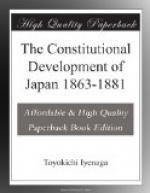“Okubo Ichizo."[7]
The result of the memorial was the ultimate removal of the seat of government from Kioto to Yedo, which afterwards changed its name to Tokio, meaning eastern capital.
But the most important event of the Restoration, from the constitutional point of view, was the charter oath of five articles, taken by the present Emperor on the 17th of April, 1869, before the court and the assembly of Daimios. These articles were in substance as follows:
1. A deliberative assembly should be formed, and all measures be decided by public opinion.
2. The principles of social and political economics should be diligently studied by both the superior and inferior classes of our people.
3. Every one in the community shall be assisted to persevere in carrying out his will for all good purposes.
4. All the old absurd usages of former times should be disregarded, and the impartiality and justice displayed in the workings of nature be adopted as a basis of action.
5. Wisdom and ability should be sought after in all quarters of the world for the purpose of firmly establishing the foundations of the empire.
The Emperor’s promise henceforth became the watchword of the nation.
And this resolution to form a deliberative assembly was soon put into practice. In 1869 was convened the Kogisho or “Parliament,” as Sir Harry Parkes translates it in his despatch to the Earl of Clarendon. But before we proceed to the description of the nature and working of the Kogisho it is necessary to state that this plan had been already suggested by the Shogunate. A proclamation of the Shogun Keiki, issued on February 20, 1868, says: “As it is proper to determine the principle of the constitution of Japan with due regard to the wishes of the majority, I have resigned the supreme power to the Emperor’s court, and advised that the opinions of all the Daimios should be taken.... On examination of my household affairs (the administration of Shogun’s territories), many irregularities may exist which may dissatisfy the people, and which I therefore greatly deplore. Hence I intend to establish a Kogijio and to accept the opinion of the majority. Any one, therefore, who has an opinion to express may do so at that place and be free of apprehension."[8]
But this attempt of the Shogun to establish a sort of Parliament came to an end with his fall. This idea, however, was transmitted through the Shogunate officials to the government of the Restoration. In fact, this idea of consulting public opinion was, as I have repeatedly said, in the air. The leaders of the new government all felt, as one of them said to Messrs. F.O. Adams and Ernest Satow, that “the only way to allay the jealousies hitherto existing between several of the most powerful clans, and to ensure a solid and lasting union of conflicting interests, was to search for the nearest approach to an ideal constitution among those of Western countries ... that the opinion of the majority was the only criterion of a public measure."[9]




